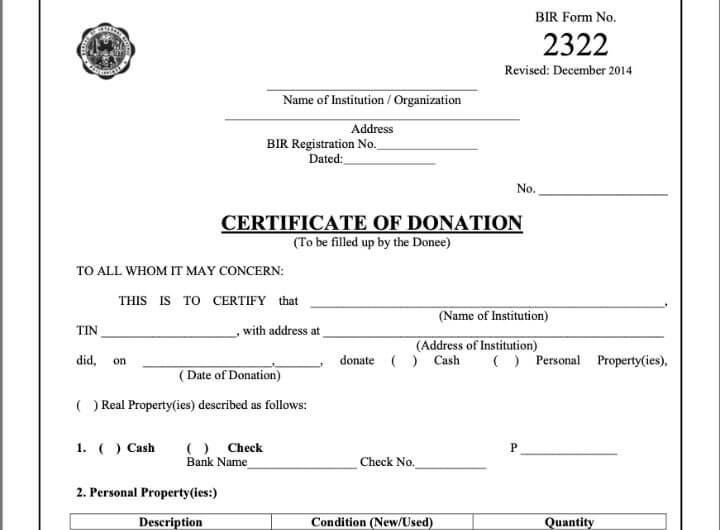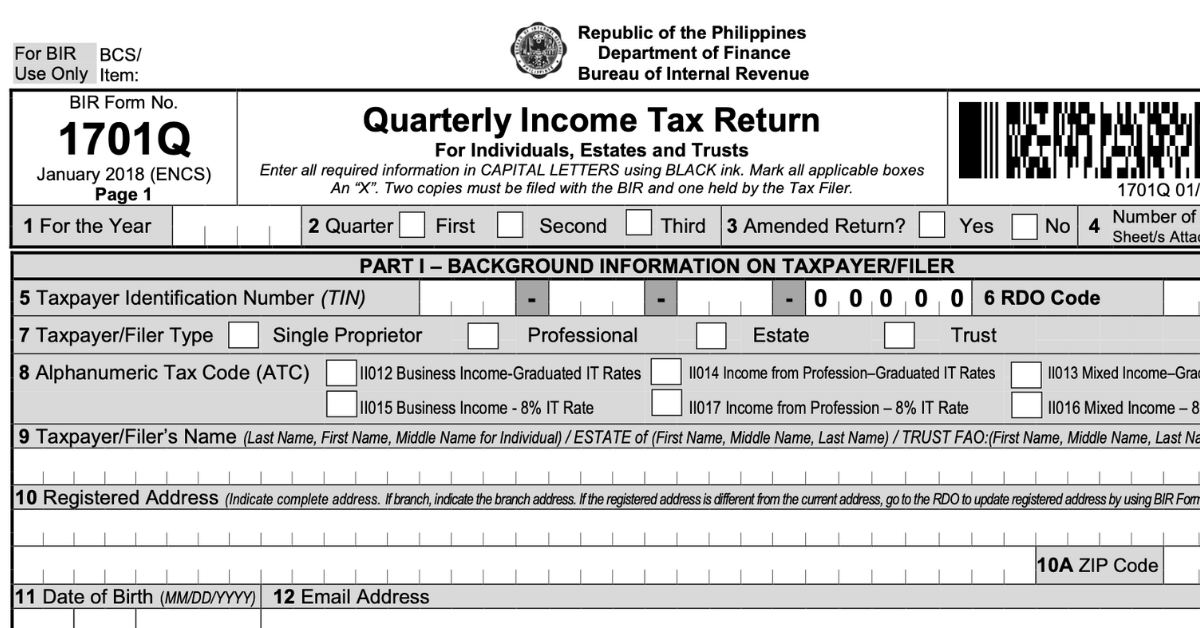As some of you may be aware, the 8 income tax rate option law went into effect last year. What does this mean for business owners and professionals? How will it affect your practice? In this post, we’ll provide an overview of the new law and discuss how it may impact you. Stay tuned for more blog posts on this topic in the coming weeks. We hope this information is helpful!
What is 8 Income Tax Rate for Sole Proprietorship Tax or Practice of Profession?
The 8% flat rate on the practice of professions is a new law that requires all professionals who are registered with the PRC to pay 8% tax on their gross income. This includes those who are sole proprietors, as well as employees of professional services firms. The 8% tax will be imposed on the gross receipts from the practice of the profession, less allowable expenses.
For sole proprietorships, the 8% flat rate will be applied to the total revenue from the business. For professional services firms, the 8% flat rate will be applied to the total fees charged for services rendered by employees who are members of the covered profession.
What is the difference between the normal income tax rate and the 8 Income Tax Rate?
The 8% flat rate is a new, lower tax rate that will be applied to the gross income from the practice of professions. The normal income tax rates range from 5% to 32%, depending on the amount of income earned.
How can you avail the 8 Income Tax Rate?
You can avail the 8% flat rate if you are a registered professional and you have paid your professional tax. You will need to submit a copy of your registration certificate and proof of payment of your professional tax to the Bureau of Internal Revenue.
This filing option is available for self employed individuals who have gross sales/receipts that do not exceed 3,000,000 PHP. They are not subject to Percentage tax. In this case, they can choose from two options:
a.) Use graduated income tax rates (follow the regular rates for individuals):
b.) Pay an 8% tax on gross sales/receipts that exceed 250,000 PHP
The 8% tax rate is a good option because you don’t need to do anything else after you choose it. You just have to subtract the first 250,000 PHP from your gross sales/receipts and multiply the difference by 8%. This will be your tax amount.
Related: No Payment of Tax on Your Online Business in the Philippines
Who Can Avail the 8 Income Tax Rate Option?
The 8% flat rate is available to any individual earning from the practice of a profession. This includes, but is not limited to, doctors, lawyers, accountants, engineers, and architects.
According to Revenue Memorandum Order No. 23-2018, in order to be eligible for the 8% Income Tax Rate, you must meet the following criteria:
- The individual taxpayer must be self-employed (a single proprietor, professional, or mixed income earner).
- The taxpayer must be registered and subject to percentage tax (or a non-VAT filer).
- The taxpayer must have expressed their intention of availing the 8% Income Tax Rate.
How to Apply 8 Income Tax Rate Option?
If you are eligible, you can choose to have 8% tax on your registration income by doing the following:
- Submit Form 1905 to end date percentage tax on your registration income.
- If you did not end-date percentage tax, continue to submit 2551Q quarterly percentage tax returns with a note that you are choosing 8% Gross Sales/Receipts Tax.
- Submit the initial quarterly income tax return (1701Q) for the year with a note that you are choosing 8% Gross Sales/Receipts Tax.
If you want to pay 8% income tax, you can choose to do one of two things:
(1) Update your registration using BIR Form 1905 or
(2) Check the appropriate option in the new 2551Q form or the new 1701Q form.
But once you make this choice, it will be for the whole year and you cannot change it. This is similar to how taxpayers currently choose to pay Optional Standard Deductions (OSD).
How To Compute Tax Due Using 8 Income Tax Rate?
Total gross sales or receipts less non-taxable income of two hundred fifty thousand pesos multiply by 8 income tax rate. However, if mixed income earner no deduction of two hundred fifty thousand pesos (250,000) since the this amount was deducted from the compensation income.
People who practice a profession cannot divide 250,000 into four quarters to make deductions. The revised quarterly income tax rate returns reflect the total quarterly computation.
Who Are Disqualified To 8 Income Tax Rate Option?
The 8% income tax rate is not available to the following taxpayers:
Withholding Agent: An individual or corporation, partnership, association, or any other entity required to withhold and remit taxes on behalf of their employees or payees.
Non-VAT taxpayers with total annual sales/receipts exceeding 3,000,000 PHP:
This includes those who are subject to excise tax and/or value-added tax (VAT).
Minimum Wage Earners (MWEs):
These taxpayers are not required to file an income tax return because they are already exempt from income tax.
Tax Exempted Individuals:
These taxpayers are already exempt from income tax and, as such, are not required to file an income tax return.
Employer-Employee Relationship:
These taxpayers are subject to withholding tax on compensation and, as such, are not required to file an income tax return.
Partners of a GPP (General Professional Partnership):
These taxpayers are not required to file an income tax return because they are already exempt from income tax.
Do I Still Need To File An Annual Income Tax Return If I 8 Income Tax Rate?
Yes, you will still need to file an annual income tax return even if you avail of the 8% income tax rate. This is because the 8% rate is only applied to your quarterly income tax payments and not to your annual income tax due.
For example, if your annual taxable income is 1,000,000 PHP and you choose to pay using the 8% income tax rate, your quarterly payments will be 8% of 250,000 PHP or 20,000 PHP per quarter. However, your annual income tax due will still be 1,000,000 PHP x 20% or 200,000 PHP.
Income tax return must be filed on or before April 15 of the year following the calendar year in which the income was earned using BIR Form 1700 for individuals and BIR Form 1701 for mixed income earners.
How 8 Income Tax Rate Option Benefited You?
The 8% flat rate is a good option for those who are self-employed or have a small business because it is a simple way to calculate your taxes. You just need to subtract the first 250,000 PHP from your gross sales/receipts and multiply the difference by 8%. This will be your tax amount.
Less Tax Rate
8% is much lower compared to the graduated income tax rates which is currently 32%. 8% is also lower than the old minimum corporate income tax rate of 10%.
Simplified Computation
The 8% flat rate is a simplified way to compute your taxes. You no longer need to keep track of your expenses and deduct them from your gross sales/receipts. All you need to do is subtract the first 250,000 PHP from your gross sales/receipts and multiply the difference by 8%.
No More Quarterly Payments of Business Taxes
With the 8% flat rate, you need to file your 8 income tax return on a quarterly basis however, no business taxes to be filed in the BIR.
No Financial Statement
There is no need to prepare a financial statement when you avail of the 8% flat rate.
Related: How to Use the Double Entry System in Your Businesses
Disadvantages of Using 8 Income Tax Rate?
Fixed Rate of 8%
The 8% flat rate is a fixed rate which means that it does not change even if your income increases or decreases. This can be disadvantageous because you will end up paying more tax if your income increases.
Limited to Professions and Self-Employed Only
The 8% flat rate is only available to those who are self-employed or have a small business. This means that employees and other taxpayers who are not self-employed or do not have a small business will not be able to avail of this option.
Not Available to All
As mentioned above, the 8% flat rate is not available to all taxpayers. Withholding agents, non-VAT taxpayers with total annual sales/receipts exceeding 3,000,000 PHP, and those who are required to use the quarterly accounting period are not eligible for this option.
No Itemized Deductions
The 8% flat rate does not allow for itemized deductions. This means that you cannot deduct your expenses from your gross sales/receipts.
No Optional Standard Deductions
The 8% flat rate does not allow for optional standard deductions. This means that you cannot deduct a fixed amount from your gross sales/receipts regardless of your actual expenses.
Related: How to Reduce Your Philippine Tax in 2020
8 Income Tax Rate of Normal Income Tax Rate?
The 8% flat rate is a new option that is available to those who are self-employed or have a small business. The 8% flat rate is lower than the normal income tax rate of 32%. This means that you will save money on your taxes if you choose this option.
However, there are some disadvantages to using the 8% flat rate. One disadvantage is that it is a fixed rate which means that it does not change even if your income increases or decreases. Another disadvantage is that it is only available to those who are self-employed or have a small business.
You need to weigh the advantages and disadvantages of using the 8% flat rate before you decide whether or not to use this option.
Conclusion
The 8% flat rate on the practice of professions or self-employment is a new law in the Philippines that affects taxpayers. This blog post has explained the details of the new profession tax train law in the Philippines, and has helped you determine how it may affect you. It has also provided you with a difference between the normal income tax rate and flat rate of 8%. Finally, it has explained how the 8% flat rate option can benefit you.
Recommended: How to Register Your Business as Barangay Micro Business Enterprise (BMBEs)

















Harry
Hello Sir Rosben, I was your former student at St. Paul and is now a CPA (just recently) and thank you for all these blogs you are publishing as this helps me as I prepare AITR for my clients. Damo nga salamat Sir!